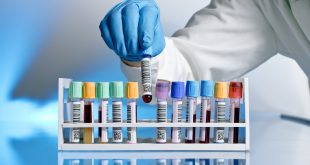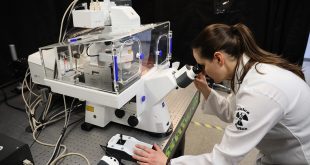By harnessing the power of artificial intelligence, Canadian researchers have managed to target a potential treatment for a drug-resistant bacteria
By Sean Tarry
When it comes to medical discoveries that pose a significant impact on the future of research and innovation, few can be considered more important than the one recently made by McMaster University scientist Jonathan Stokes. Together with his research team, Stokes leveraged the power of artificial intelligence (AI), training a model in order to predict new antibacterial molecules against a bacterial pathogen called Acinetobacter baumannii. This bacterium is one of the ESKAPE pathogens, a highly virulent and multidrug-resistant group of pathogens that pose incredible difficulty and challenges when an outbreak occurs. In fact, A. baumannii, a hospital-acquired pathogen, is at the top of the World Health Organization’s list of bacterial pathogens for which new antibiotics are urgently needed.
AI-guided discovery
Commonly found on surfaces in clinical settings, the pathogen is known to cause diseases such as pneumonia, meningitis, and sepsis, resulting in a number of different complications for patients battling other unrelated illnesses and, indeed, for the physicians and healthcare professionals attempting to treat their illnesses. It’s a pathogen that, until the introduction of AI to the conversation and set of tools available to researchers, has been exceptionally stubborn with respect to revealing its vulnerabilities or weakness against antibacterials. By training an AI model, however, using laboratory data assessing the antibacterial efficacy of a large collection of molecules against A. baumannii, Stokes and his team set out to expose its frailty by predicting new antibiotics against it.
“We started the project by going into the lab and testing somewhere in the region of 7,500 molecules to see which of these would inhibit the growth of A. baumannii in a dish,” he explains. “After performing this chemical screen, we trained a model on the structures of all the chemicals that were able to inhibit the growth of A. baumannii — hits — as well as the structures of the chemicals that were not able to inhibit the growth of A. baumannii — non-hits. We then took this ‘binarized’ dataset and trained a neural network model on the structures of all hits and all non-hits. What the model learned were chemical features associated with antibacterial activity, as well as chemical features not associated with antibacterial activity.”
Training the model
Once the model was trained, Stokes goes on to explain, he and his team were then able to show it structures of the roughly 7,000 novel compounds it had not seen during its original training. In the end, the model was able to predict which molecules might be antibacterial against A. baumannii and which were unlikely to be, based on their chemical structures alone. After assessing the most likely antibacterial molecules for laboratory activity based on model predictions, the team filtered the laboratory-active molecules for structural novelty before discovering abaucin as a structurally novel and potent antibacterial molecule against A. baumannii.
“Abaucin is a structurally novel antibacterial molecule with a novel biochemical function that displays ‘narrow spectrum’ activity against A. baumannii,” says Stokes. “In the context of new antibiotic discovery, structural and functional novelty is essential to overcome resistance to existing antibiotic classes.”
The promise of narrow-spectrum antibiotics
The observation that abaucin is narrow spectrum can also be clinically significant, Stokes continues, explaining further that conventional antibiotics are so-called broad spectrum, meaning that they target pathogenic bacteria. But they also display antibacterial activity against commensal species, the “good” bacteria that live in and on everyone, and contribute to overall human health.
“Broad spectrum antibiotics induce dysbiosis, which has been shown to result in a wide array of negative health outcomes,” he asserts. “Narrow spectrum antibiotics are likely to avoid significant dysbiosis when administered to patients, thereby resulting in improved outcomes from antibiotic treatment. Moreover, the spread of antibiotic resistance to narrow spectrum agents is likely to be reduced relative to broad spectrum antibiotics since the former does not impose a universal selective pressure to drive resistance through entire ecological niches. This means that narrow spectrum antibiotics might have a longer duration of clinical utility without widespread resistance.”
AI’s significant impact
It’s a discovery that represents an enormous amount of promise with respect to not only the future cleanliness and sterility of hospital and clinical settings, but to the future of drug and antibacterial research and innovation. And, according to Stokes, it’s a discovery that has been aided significantly by the use of AI’s predictive qualities, which are making this type of work less onerous with respect to time and cost.
“In this study, AI was used as a method to help us rapidly assess chemicals for potent antibacterial activity in silico, which reduced the number of experiments we had to perform in the laboratory,” he says. “Stated differently, we used AI as a chemical prioritization tool. Indeed, AI models can perform predictions for novel antibacterial molecules’ orders of magnitude more rapidly than we can perform growth inhibition experiments in the laboratory. For reference, a screen of 7,000 molecules for antibacterial activity might take a few weeks of time to conduct and analyze. Our AI models can perform predictions on 7,000 molecules for antibacterial activity in a little over an hour and suggest the top few hundred molecules to test in the laboratory.”
Continued influence
In light of the fantastic results of the research executed by Stokes and his team, the project lead suggests that it’s only reasonable to expect AI-driven technologies and software to continue playing a larger role in drug and disease research and innovation going forward.
“AI-guided drug discovery is here to stay, with the goal of increasing the rate at which new drugs are discovered while
simultaneously decreasing the associated costs,” he says. “Indeed, there are hundreds of companies now leveraging AI methods for drug discovery across a wide array of diseases. In our lab, we are developing AI models for new drug discovery against numerous fungal pathogens, as well as against a type of brain cancer called glioblastoma.”
Stokes recognizes the potential that his team’s discovery represents, in addition to providing further exposure and examples regarding the utility of AI. However, he suggests that in order to properly see through a vision of the future that includes even greater AI-facilitated research and medical breakthroughs, scientists will need a lot more data concerning just about every pathogen and disease, and data that’s shared and accessible to all.
“Given the availability of sufficient quantities of high-quality disease-relevant data, AI methods can be used to help us understand disease biology and develop new therapies. However, it is often the case that large quantities of high-quality disease-relevant data do not exist in repositories that are easily accessible. In order to maximize the utility of AI for medical and life science research, we as a community of scientists need to make efforts to ensure that everyone has unrestricted access to datasets that we develop. Moreover, we need to ensure that all of these published datasets are accompanied by clear descriptions of the methodologies through which they were curated. Given that a diverse array of AI models are becoming increasingly accessible, I am confident that more researchers in health and life sciences will identify unique opportunities to accelerate their research programs through the thoughtful application of AI.”
 BioLab Business Magazine Together, we reach farther into the Canadian Science community
BioLab Business Magazine Together, we reach farther into the Canadian Science community





